2017 NISSAN FRONTIER fuel pressure
[x] Cancel search: fuel pressurePage 300 of 478

THREE-WAY CATALYST
The three-way catalyst is an emission control
device installed in the exhaust system. Exhaust
gases in the three-way catalyst are burned at
high temperatures to help reduce pollutants.
WARNING
●The exhaust gas and the exhaust sys-
tem are very hot. Keep people, animals
or flammable materials away from the
exhaust system components.
● Do not stop or park the vehicle over
flammable materials such as dry grass,
waste paper or rags. They may ignite
and cause a fire.
CAUTION
●Do not use leaded gasoline. Deposits
from leaded gasoline will seriously re-
duce the three-way catalyst’s ability to
help reduce exhaust pollutants. ●
Keep your engine tuned up. Malfunc-
tions in the ignition, fuel injection, or
electrical systems can cause overrich
fuel flow into the three-way catalyst,
causing it to overheat. Do not keep driv-
ing if the engine misfires, or if notice-
able loss of performance or other un-
usual operating conditions are
detected. Have the vehicle inspected
promptly. It is recommended that you
visit a NISSAN dealer for this service.
● Avoid driving with an extremely low fuel
level. Running out of fuel could cause
the engine to misfire, damaging the
three-way catalyst.
● Do not race the engine while warming it
up.
● Do not push or tow your vehicle to start
the engine.
TIRE PRESSURE MONITORING
SYSTEM (TPMS)
Each tire, including the spare (if provided) ,
should be checked monthly when cold and in-
flated to the inflation pressure recommended by
the vehicle manufacturer on the vehicle placard
or tire inflation pressure label. (If your vehicle has
tires of a different size than the size indicated on
the vehicle placard or tire inflation pressure label, you should determine the proper tire inflation
pressure for those tires.)
As an added safety feature, your vehicle has been
equipped with a Tire Pressure Monitoring System
(TPMS) that illuminates a low tire pressure telltale
when one or more of your tires is significantly
under-inflated. Accordingly, when the low tire
pressure telltale illuminates, you should stop and
check your tires as soon as possible, and inflate
them to the proper pressure. Driving on a signifi-
cantly under-inflated tire causes the tire to over-
heat and can lead to tire failure. Under-inflation
also reduces fuel efficiency and tire tread life, and
may affect the vehicle’s handling and stopping
ability.
Please note that the TPMS is not a substitute for
proper tire maintenance, and it is the driver’s
responsibility to maintain correct tire pressure,
even if under-inflation has not reached the level to
trigger illumination of the TPMS low tire pressure
telltale.
Your vehicle has also been equipped with a
TPMS malfunction indicator to indicate when the
system is not operating properly. The TPMS mal-
function indicator is combined with the low tire
pressure telltale. When the system detects a
malfunction, the telltale will flash for approxi-
mately 1 minute and then remain continuously
illuminated. This sequence will continue upon
Starting and driving5-3
Page 321 of 478
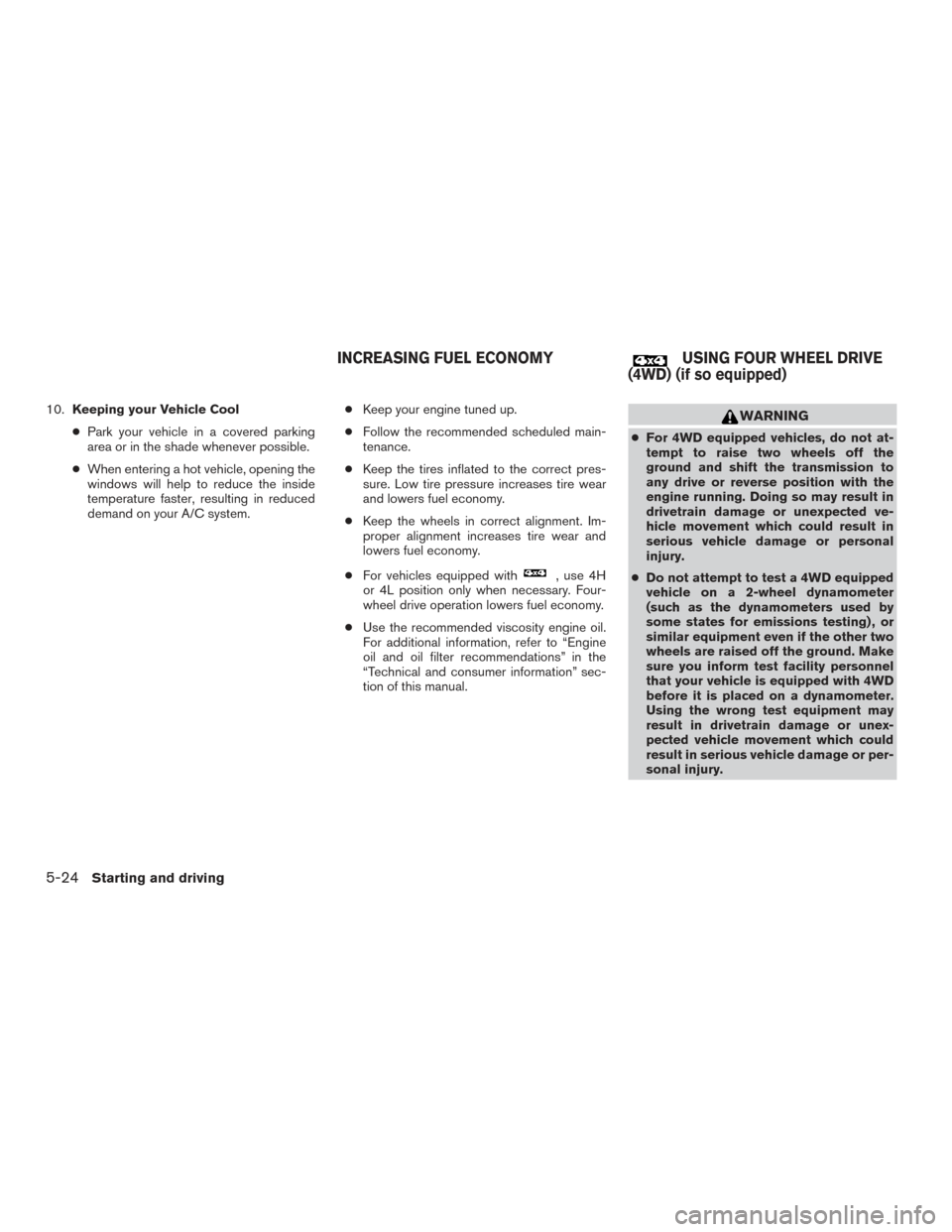
10.Keeping your Vehicle Cool
● Park your vehicle in a covered parking
area or in the shade whenever possible.
● When entering a hot vehicle, opening the
windows will help to reduce the inside
temperature faster, resulting in reduced
demand on your A/C system. ●
Keep your engine tuned up.
● Follow the recommended scheduled main-
tenance.
● Keep the tires inflated to the correct pres-
sure. Low tire pressure increases tire wear
and lowers fuel economy.
● Keep the wheels in correct alignment. Im-
proper alignment increases tire wear and
lowers fuel economy.
● For vehicles equipped with
, use 4H
or 4L position only when necessary. Four-
wheel drive operation lowers fuel economy.
● Use the recommended viscosity engine oil.
For additional information, refer to “Engine
oil and oil filter recommendations” in the
“Technical and consumer information” sec-
tion of this manual.
WARNING
●For 4WD equipped vehicles, do not at-
tempt to raise two wheels off the
ground and shift the transmission to
any drive or reverse position with the
engine running. Doing so may result in
drivetrain damage or unexpected ve-
hicle movement which could result in
serious vehicle damage or personal
injury.
● Do not attempt to test a 4WD equipped
vehicle on a 2-wheel dynamometer
(such as the dynamometers used by
some states for emissions testing) , or
similar equipment even if the other two
wheels are raised off the ground. Make
sure you inform test facility personnel
that your vehicle is equipped with 4WD
before it is placed on a dynamometer.
Using the wrong test equipment may
result in drivetrain damage or unex-
pected vehicle movement which could
result in serious vehicle damage or per-
sonal injury.
INCREASING FUEL ECONOMYUSING FOUR WHEEL DRIVE
(4WD) (if so equipped)
5-24Starting and driving
Page 369 of 478
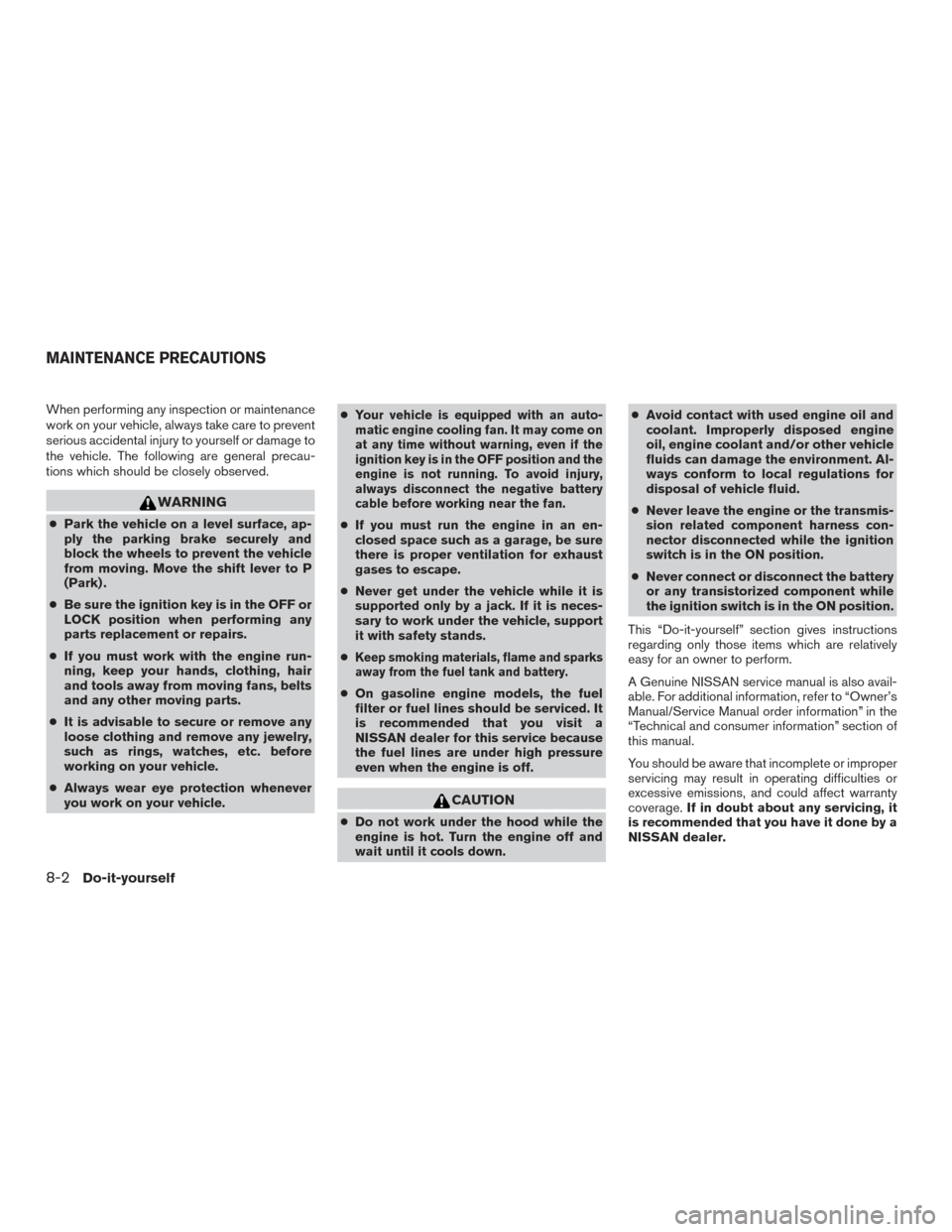
When performing any inspection or maintenance
work on your vehicle, always take care to prevent
serious accidental injury to yourself or damage to
the vehicle. The following are general precau-
tions which should be closely observed.
WARNING
●Park the vehicle on a level surface, ap-
ply the parking brake securely and
block the wheels to prevent the vehicle
from moving. Move the shift lever to P
(Park) .
● Be sure the ignition key is in the OFF or
LOCK position when performing any
parts replacement or repairs.
● If you must work with the engine run-
ning, keep your hands, clothing, hair
and tools away from moving fans, belts
and any other moving parts.
● It is advisable to secure or remove any
loose clothing and remove any jewelry,
such as rings, watches, etc. before
working on your vehicle.
● Always wear eye protection whenever
you work on your vehicle. ●
Your vehicle is equipped with an auto-
matic engine cooling fan. It may come on
at any time without warning, even if the
ignition key is in the OFF position and the
engine is not running. To avoid injury,
always disconnect the negative battery
cable before working near the fan.
●
If you must run the engine in an en-
closed space such as a garage, be sure
there is proper ventilation for exhaust
gases to escape.
● Never get under the vehicle while it is
supported only by a jack. If it is neces-
sary to work under the vehicle, support
it with safety stands.
●
Keep smoking materials, flame and sparks
away from the fuel tank and battery.
● On gasoline engine models, the fuel
filter or fuel lines should be serviced. It
is recommended that you visit a
NISSAN dealer for this service because
the fuel lines are under high pressure
even when the engine is off.
CAUTION
●Do not work under the hood while the
engine is hot. Turn the engine off and
wait until it cools down. ●
Avoid contact with used engine oil and
coolant. Improperly disposed engine
oil, engine coolant and/or other vehicle
fluids can damage the environment. Al-
ways conform to local regulations for
disposal of vehicle fluid.
● Never leave the engine or the transmis-
sion related component harness con-
nector disconnected while the ignition
switch is in the ON position.
● Never connect or disconnect the battery
or any transistorized component while
the ignition switch is in the ON position.
This “Do-it-yourself” section gives instructions
regarding only those items which are relatively
easy for an owner to perform.
A Genuine NISSAN service manual is also avail-
able. For additional information, refer to “Owner’s
Manual/Service Manual order information” in the
“Technical and consumer information” section of
this manual.
You should be aware that incomplete or improper
servicing may result in operating difficulties or
excessive emissions, and could affect warranty
coverage. If in doubt about any servicing, it
is recommended that you have it done by a
NISSAN dealer.
MAINTENANCE PRECAUTIONS
8-2Do-it-yourself
Page 469 of 478
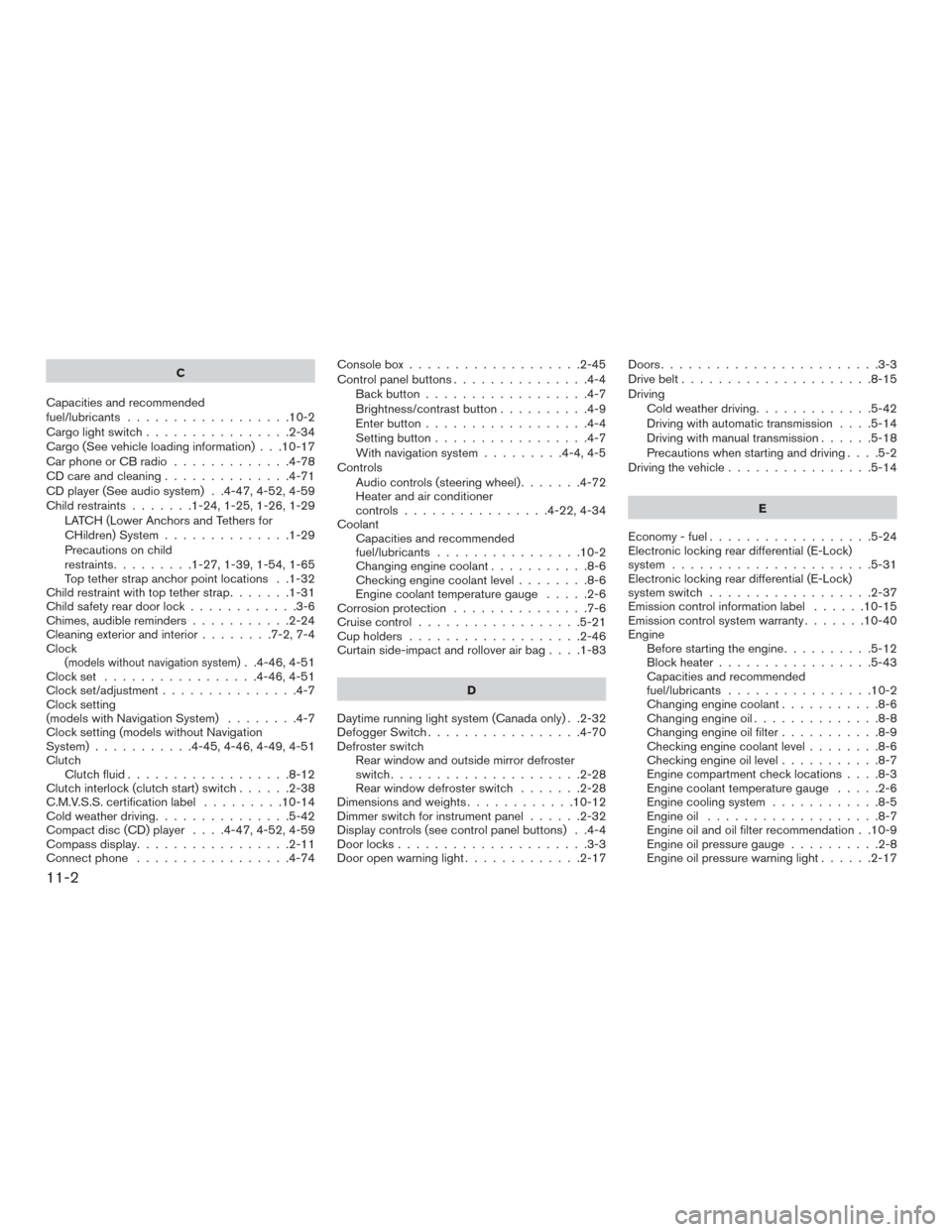
C
Capacities and recommended
fuel/lubricants ..................10-2
Cargolightswitch................2-34
Cargo (See vehicle loading information) . . .10-17
Car phone or CB radio .............4-78
CD care and cleaning ..............4-71
CD player (See audio system) . .4-47, 4-52, 4-59
Child restraints .......1-24,1-25,1-26,1-29
LATCH (Lower Anchors and Tethers for
CHildren) System ..............1-29
Precautions on child
restraints.........1-27,1-39,1-54,1-65
Top tether strap anchor point locations . .1-32
Child restraint with top tether strap .......1-31
Child safety rear door lock ............3-6
Chimes, audible reminders ...........2-24
Cleaningexteriorandinterior........7-2,7-4
Clock
(models without navigation system). .4-46, 4-51
Clockset .................4-46,4-51
Clock set/adjustment ...............4-7
Clock setting
(models with Navigation System) ........4-7
Clock setting (models without Navigation
System) ...........4-45,4-46,4-49,4-51
Clutch Clutch fluid ..................8-12
Clutch interlock (clutch start) switch ......2-38
C.M.V.S.S. certification label .........10-14
Cold weather driving ...............5-42
Compact disc (CD) player ....4-47,4-52,4-59
Compass display .................2-11
Connect phone .................4-74 Console box
...................2-45
Control panel buttons ...............4-4
Back button ..................4-7
Brightness/contrast button ..........4-9
Enterbutton..................4-4
Setting button .................4-7
With navigation system .........4-4,4-5
Controls Audio controls (steering wheel) .......4-72
Heater and air conditioner
controls................4-22,4-34
Coolant Capacities and recommended
fuel/lubricants ................10-2
Changingenginecoolant...........8-6
Checking engine coolant level ........8-6
Engine coolant temperature gauge .....2-6
Corrosion protection ...............7-6
Cruisecontrol..................5-21
Cupholders...................2-46
Curtainside-impactandrolloverairbag....1-83
D
Daytime running light system (Canada only) . .2-32
Defogger Switch .................4-70
Defroster switch Rear window and outside mirror defroster
switch.....................2-28
Rear window defroster switch .......2-28
Dimensionsandweights............10-12
Dimmer switch for instrument panel ......2-32
Display controls (see control panel buttons) . .4-4
Door locks .....................3-3
Door open warning light .............2-17 Doors
........................3-3
Drive belt .....................8-15
Driving Cold weather driving .............5-42
Driving with automatic transmission ....5-14
Driving with manual transmission ......5-18
Precautions when starting and driving ....5-2
Driving the vehicle ................5-14
E
Economy-fuel..................5-24
Electronic locking rear differential (E-Lock)
system ......................5-31
Electronic locking rear differential (E-Lock)
system switch ..................2-37
Emission control information label ......10-15
Emission control system warranty .......10-40
Engine Before starting the engine ..........5-12
Blockheater.................5-43
Capacities and recommended
fuel/lubricants ................10-2
Changing engine coolant ...........8-6
Changingengineoil..............8-8
Changing engine oil filter ...........8-9
Checking engine coolant level ........8-6
Checking engine oil level ...........8-7
Engine compartment check locations ....8-3
Engine coolant
temperature gauge .....2-6
Engine cooling system ............8-5
Engineoil ...................8-7
Engine oil and oil filter recommendation . .10-9
Engineoilpressuregauge..........2-8
Engine oil pressure warning light ......2-17
11-2
Page 470 of 478
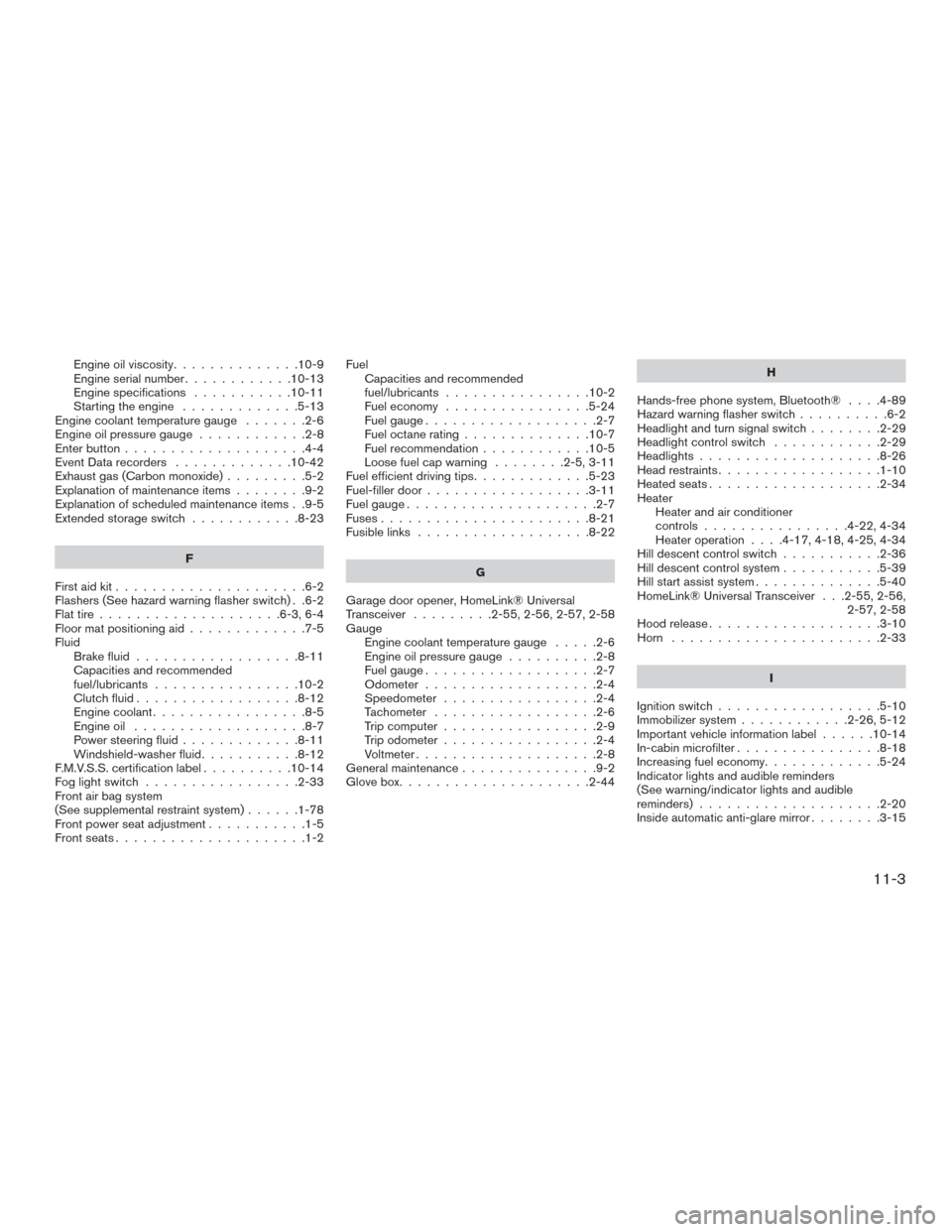
Engine oil viscosity..............10-9
Engine serial number ............10-13
Engine specifications ...........10-11
Starting the engine .............5-13
Engine coolant temperature gauge .......2-6
Engineoilpressuregauge............2-8
Enterbutton....................4-4
Event Data recorders .............10-42
Exhaust gas (Carbon monoxide) .........5-2
Explanation of maintenance items ........9-2
Explanation of scheduled maintenance items . .9-5
Extendedstorageswitch ............8-23
F
First aid kit .....................6-2
Flashers (See hazard warning flasher switch) . .6-2
Flat tire ....................6-3,6-4
Floor mat positioning aid .............7-5
Fluid Brake fluid ..................8-11
Capacities and recommended
fuel/lubricants ................10-2
Clutchfluid..................8-12
Engine coolant .................8-5
Engine oil ...................8-7
Power steering fluid .............8-11
Windshield-washerfluid...........8-12
F.M.V.S.S. certification label ..........10-14
Foglightswitch .................2-33
Front air bag system
(See supplemental restraint system) ......1-78
Front power seat adjustment ...........1-5
Frontseats.....................1-2 Fuel
Capacities and recommended
fuel/lubricants ................10-2
Fuel economy ................5-24
Fuel gauge ...................2-7
Fuel octane rating ..............10-7
Fuel recommendation ............10-5
Loose fuel cap warning ........2-5,3-11
Fuel efficient driving tips .............5-23
Fuel-filler door ..................3-11
Fuelgauge.....................2-7
Fuses.......................8-21
Fusiblelinks ...................8-22
G
Garage door opener, HomeLink® Universal
Transceiver .........2-55,2-56,2-57,2-58
Gauge Engine coolant temperature gauge .....2-6
Engine oil pressure gauge ..........2-8
Fuel gauge ...................2-7
Odometer ...................2-4
Speedometer .................2-4
Tachometer ..................2-6
Trip computer .................2-9
Trip odometer .................2-4
Voltmeter....................2-8
General maintenance ...............9-2
Glovebox.....................2-44 H
Hands-free phone system, Bluetooth® ....4-89
Hazard warning flasher switch ..........6-2
Headlightandturnsignalswitch........2-29
Headlightcontrolswitch ............2-29
Headlights....................8-26
Head restraints ..................1-10
Heated seats ...................2-34
Heater Heater and air conditioner
controls ................4-22,4-34
Heater operation ....4-17,4-18,4-25,4-34
Hill descent control switch ...........2-36
Hill descent
control system ...........5-39
Hill start assist system ..............5-40
HomeLink® Universal Transceiver . . .2-55, 2-56, 2-57, 2-58
Hoodrelease...................3-10
Horn .......................2-33
I
Ignition switch ..................5-10
Immobilizer system ............2-26,5-12
Important vehicle information label ......10-14
In-cabin microfilter ................8-18
Increasing fuel economy .............5-24
Indicator lights and audible reminders
(See warning/indicator lights and audible
reminders)....................2-20
Inside automatic anti-glare mirror ........3-15
11-3
Page 471 of 478
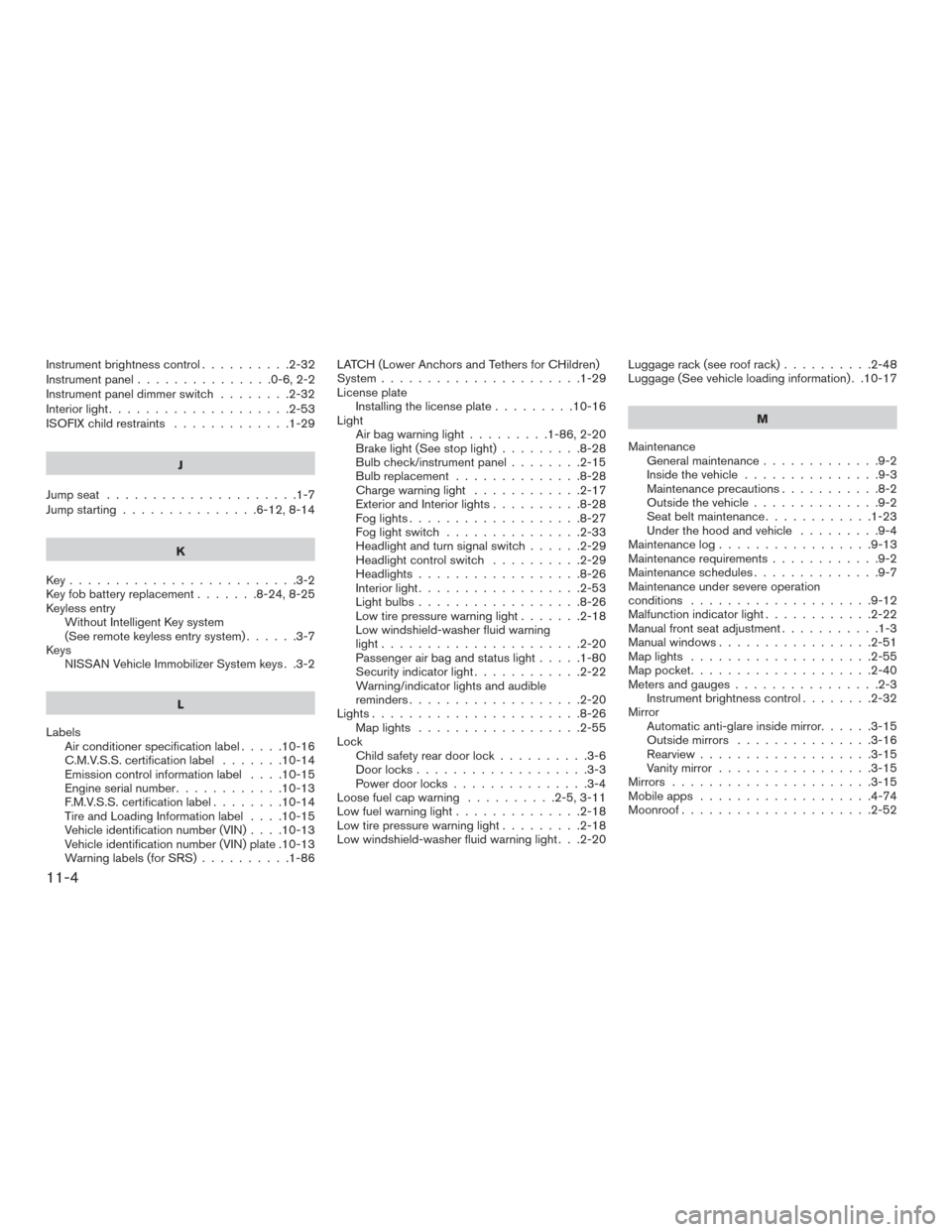
Instrument brightness control..........2-32
Instrument panel ...............0-6,2-2
Instrument panel dimmer switch ........2-32
Interiorlight....................2-53
ISOFIX child restraints .............1-29
J
Jumpseat .....................1-7
Jump starting ...............6-12,8-14
K
Key.........................3-2
Key fob battery replacement .......8-24,8-25
Keyless entry Without Intelligent Key system
(See remote keyless entry system) ......3-7
Keys NISSAN Vehicle Immobilizer System keys . .3-2
L
Labels Air conditioner specification label .....10-16
C.M.V.S.S. certification label .......10-14
Emissioncontrolinformationlabel ....10-15
Engine serial number ............10-13
F.M.V.S.S. certification label ........10-14
Tire and Loading Information label ....10-15
Vehicle identification number (VIN) ....10-13
Vehicle identification number (VIN) plate .10-13
Warning labels (for SRS) ..........1-86LATCH (Lower Anchors and Tethers for CHildren)
System
......................1-29
License plate Installing the license plate .........10-16
Light Air bag warning light .........1-86,2-20
Brake light (See stop light) .........8-28
Bulb check/instrument panel ........2-15
Bulbreplacement..............8-28
Charge warning light ............2-17
Exterior and Interior lights ..........8-28
Foglights...................8-27
Foglightswitch ...............2-33
Headlight and turn signal switch ......2-29
Headlight control switch ..........2-29
Headlights..................8-26
Interiorlight..................2-53
Lightbulbs..................8-26
Low tire pressure warning light .......2-18
Low windshield-washer fluid warning
light......................2-20
Passenger air bag and status light .....1-80
Security indicator light ............2-22
Warning/indicator lights and audible
reminders ...................2-20
Lights.......................8-26 Maplights ..................2-55
Lock Child safety rear door lock ..........3-6
Door locks ...................3-3
Power door locks ...............3-4
Loose fuel cap warning ..........2-5,3-11
Lowfuelwarninglight..............2-18
Low tire pressure warning light .........2-18
Low windshield-washer fluid warning light . . .2-20 Luggage rack (see roof rack)
..........2-48
Luggage (See vehicle loading information) . .10-17
M
Maintenance General maintenance .............9-2
Insidethevehicle...............9-3
Maintenance precautions ...........8-2
Outside the vehicle ..............9-2
Seat belt maintenance ............1-23
Under the hood and vehicle .........9-4
Maintenancelog.................9-13
Maintenance requirements ............9-2
Maintenance schedules ..............9-7
Maintenance under severe operation
conditions ....................
9
-12
Malfunction indicator light ............2-22
Manual front seat adjustment ...........1-3
Manual windows .................2-51
Maplights ....................2-55
Mappocket....................2-40
Meters and gauges ................2-3
Instrument brightness control ........2-32
Mirror Automatic anti-glare inside mirror ......3-15
Outside mirrors ...............3-16
Rearview ...................3-15
Vanity mirror .................3-15
Mirrors ......................3-15
Mobileapps ...................4-74
Moonroof .....................2-52
11-4
Page 474 of 478

Tie down hooks.................3-23
Tilting steering wheel ..............3-13
Tire Flat tire ..................6-3,6-4
Spare tire ...................6-5
TireandLoadingInformationlabel ....10-15
Tire chains ..................8-37
Tirepressure.................8-30
Tire rotation..................8-37
Tires of 4-wheel drive ............8-40
Types of tires .................8-36
Uniform tire quality grading ........10-39
Wheels and tires ..........8-30,10-12
Wheel/tire size ...............10-12
Tire pressure Low tire pressure warning light .......2-18
Tire Pressure Monitoring System (TPMS) ....5-3
Top tether strap child restraint .........1-31
Towing 2-wheel drive models ............6-16
4-wheel drive models ............6-16
Flattowing.................10-38
Towing load/specification .........10-31
Towtrucktowing...............6-15
Trailer towing ................10-27
Towing a trailer .................10-27
Transceiver HomeLink® Universal
Transceiver .......2-55,2-56,2-57,2-58
Transmission Driving with automatic transmission ....5-14
Driving with manual transmission ......5-18
Travel (See registering a vehicle in another
country) .....................10-13
Trip computer ...................2-9
Trip odometer ...................2-4 Troubleshooting guide (NISSAN voice recognition
system)
.....................4-103
Truckbox .................3-18,3-18
Truck - camper loading ............10-25
Turn signal switch ................2-33
U
Uniform tire quality grading ..........10-39
USB interface Audio file operation ..........4-61,4-63
V
Vanity mirror ...................3-15
Variable voltage control system .........8-15
Vehicle dimensions and weights .......10-12
Vehicle dynamic control (VDC) off switch . . .2-35
Vehicle dynamic control (VDC) system .....5-37
Vehicle Dynamic Control (VDC) system ....5-37
Vehicle identification ..............10-13
Vehicle identification number (VIN) ......10-13
Vehicle identification number (VIN) plate . . .10-13
Vehicle immobilizer system ........2-26,5-12
Vehicle loading information ..........10-17
Vehicle recovery .................6-17
Vehicle security system .............2-24
Vehicle security system (NISSAN Vehicle
Immobilizer System) , engine start ....2-26,5-12
Ventilators ....................4-16
Visors.......................3-14
Voice Prompt Interrupt ..........4-81,4-92
Voice recognition system ............4-99
Voltmeter......................2-8 W
Warning 4WD warning light ..............
2
-15
Airbagwarninglight.........1-86,2-20
Anti-lock brake warning light ........2-15
Battery charge warning light ........2-17
Brake warning light .............2-16
Door open warning light ...........2-17
Engine oil pressure warning light ......2-17
Hazard warning flasher switch ........6-2
Loose fuel cap warning ........2-5,3-11
Low fuel warning light ............2-18
Low tire pressure warning light .......2-18
Low windshield-washer fluid warning
light......................2-20
Passenger air bag and status light .....1-80
Seat belt warning light ........1-18,2-20
Supplemental air bag warning
light ..................1-86,2-20
Vehicle security system ...........2-24
Warning/indicator lights and audible
reminders ...................2-20
Warning labels (for SRS) ..........1-86
Warning/indicator lights and audible
reminders.....................2-20 Audiblereminders..............2-20
Indicatorlights................2-20
Warning lights ................2-20
Warning lights ..................2-20
Warning lights, indicator lights and audible
reminders.....................2-14
Weights (See dimensions and weights) . . .10-12
Wheels and tires ............8-30,10-12
Wheel/tire size .................10-12
11-7